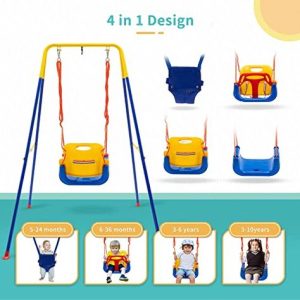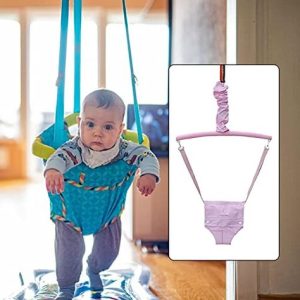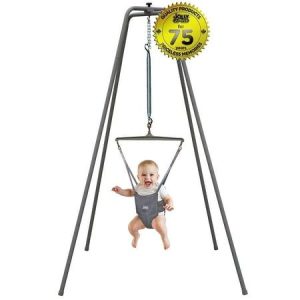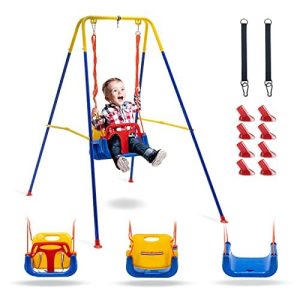At What Age Can Babies Use A Jumper? Every parent wants their baby to be happy and healthy. Jumper toys can be a great source of entertainment for little ones, but it’s important to use them safely. This article will explore the appropriate age for introducing a jumper to your baby, along with safety tips and developmental benefits.
When is the Right Time for a Jumper?
Age and Development Milestones
The American Academy of Pediatrics (AAP) recommends waiting until babies can hold their heads up independently before using a jumper. This typically occurs around five to six months old. However, every baby develops at their own pace. Here are some signs your baby might be ready for a jumper:
- Good head and neck control: Your baby can hold their head steady without support when upright.
- Can bounce: Your baby pushes down on their legs with some force.
- Shows interest: Your baby seems curious about the jumper and wants to reach for toys.
Weight and Height Limits
Always follow the manufacturer’s weight and height limits for the specific jumper you are using. These limits are in place for your baby’s safety.

Essential Safety Tips for Jumper Use
Jumper Setup
- Find a safe space: Use the jumper on a level, sturdy surface away from furniture, walls, or anything else your baby could bump into.
- Doorway jumpers: Only use doorway jumpers in doorways with secure frames that meet the manufacturer’s weight and size requirements.
- Inspect the jumper: Check for any loose straps, worn parts, or damage before each use.
- Never leave your baby unattended: Always supervise your baby closely while they are in the jumper.
- Limit jumping time: Start with short sessions (10-15 minutes) and gradually increase the time as your baby gets used to it.
- Take breaks: Give your baby plenty of breaks outside the jumper for floor time and tummy time.
Jumper Positioning
- Proper fit: Ensure the straps are adjusted according to the manufacturer’s instructions for a snug but comfortable fit.
- Leg movement: Allow plenty of legroom for your baby to kick and bounce freely.
Developmental Benefits of Jumpers
Physical Development
- Strengthens leg muscles: Jumping helps strengthen leg muscles, which are important for future development like walking and running.
- Improves coordination: The bouncing motion helps with eye-hand coordination and balance.
Cognitive Development
- Cause and effect: Babies learn that their movements cause the jumper to bounce, which can be stimulating and engaging.
- Exploration: Many jumpers have toys and attachments that can encourage your baby to reach, grasp, and explore.

Alternatives to Jumpers
Floor Play
Tummy time and floor play are essential for babies’ development. A play mat with engaging toys provides a safe space for your baby to explore, roll over, and build strength.
Exersaucers
Exersaucers offer a stationary activity center with toys and attachments that can keep your baby entertained. Look for an exersaucer that allows for 360-degree swiveling so your baby can explore all the activities.
Conclusion
Jumper toys can be a fun and safe way for your baby to play once they meet the developmental milestones. By following safety guidelines and limiting use, you can help ensure your baby enjoys a happy and healthy bouncing experience.
Fun Activities for Your Baby in a Jumper
Toys and Engagement
- Add some toys: Consider placing a few age-appropriate toys within reach inside the jumper to keep your baby entertained. Opt for soft, colorful toys with different textures and sounds.
- Sing songs and interact: Make playtime in the jumper interactive! Sing songs, narrate your baby’s movements, and point out interesting objects in the room.
- Change the scenery: If you have a safe, spacious area, occasionally move the jumper to a new location in the house to give your baby a fresh perspective.
Variety is Key
- Limit jumper time: While jumpers can be a fun activity, it’s important to limit their use. Experts recommend sessions in short bursts (10-15 minutes) to prevent overuse.
- Alternate with other activities: Balance jumper time with plenty of floor time, tummy time, and cuddling throughout the day. This variety helps with overall development and prevents boredom.
The Takeaway
Jumper toys can be a great addition to your baby’s playtime once they meet the age and developmental requirements. Remember, safety is paramount. Always supervise your baby closely, follow manufacturer instructions, and limit jumping time. By incorporating these tips, you can create a fun and enriching experience for your little one.

Choosing the Right Jumper for Your Baby
With so many jumper options available, selecting the right one for your baby can feel overwhelming. Here are some factors to consider:
- Age and weight limits: Double-check the specific limits for the jumper you’re interested in. These are in place for your baby’s safety.
- Jumper type: There are two main types of jumpers: doorway jumpers and freestanding jumpers. Doorway jumpers attach to a secure doorway frame, while freestanding jumpers have their own base for stability.
Doorway Jumpers
- Pros: Doorway jumpers are generally more affordable and compact, making them a good option for smaller spaces.
- Cons: Doorway jumpers may not be suitable for all doorways, and they require a secure installation.
Freestanding Jumpers
- Pros: Freestanding jumpers offer more flexibility in placement and may have a wider range of features and toys.
- Cons: Freestanding jumpers tend to be larger and pricier than doorway jumpers.
Additional Considerations
- Comfort and adjustability: Look for a jumper with a padded seat and adjustable straps to ensure your baby is comfortable and secure.
- Washable materials: Accidents happen, so choose a jumper with a seat and straps that can be easily wiped clean or machine washed.
- Toys and attachments: Some jumpers come with attached toys or offer the option to add them on. Consider your baby’s age and interests when choosing toys.
Keeping the Playtime Positive
Signs it’s Time for a Break
- Fussiness or crying
- Leaning on the sides of the jumper
- Appearing tired or drowsy
When your baby shows these signs, it’s time to take a break from the jumper. Pick them up, cuddle them, or transition them to a different activity.
Remember:
- Playtime should be enjoyable for both you and your baby.
- Pay attention to your baby’s cues and take breaks when needed.
- Jumper time is just one part of your baby’s development. Balance it with plenty of floor time and other activities.
By following these tips, you can ensure that jumper playtime is a positive and enriching experience for your baby.


